Andreas Brendel
DeePAQ: A Perceptual Audio Quality Metric Based On Foundational Models and Weakly Supervised Learning
Oct 14, 2025Abstract:This paper presents the Deep learning-based Perceptual Audio Quality metric (DeePAQ) for evaluating general audio quality. Our approach leverages metric learning together with the music foundation model MERT, guided by surrogate labels, to construct an embedding space that captures distortion intensity in general audio. To the best of our knowledge, DeePAQ is the first in the general audio quality domain to leverage weakly supervised labels and metric learning for fine-tuning a music foundation model with Low-Rank Adaptation (LoRA), a direction not yet explored by other state-of-the-art methods. We benchmark the proposed model against state-of-the-art objective audio quality metrics across listening tests spanning audio coding and source separation. Results show that our method surpasses existing metrics in detecting coding artifacts and generalizes well to unseen distortions such as source separation, highlighting its robustness and versatility.
Leveraging Discriminative Latent Representations for Conditioning GAN-Based Speech Enhancement
Aug 28, 2025Abstract:Generative speech enhancement methods based on generative adversarial networks (GANs) and diffusion models have shown promising results in various speech enhancement tasks. However, their performance in very low signal-to-noise ratio (SNR) scenarios remains under-explored and limited, as these conditions pose significant challenges to both discriminative and generative state-of-the-art methods. To address this, we propose a method that leverages latent features extracted from discriminative speech enhancement models as generic conditioning features to improve GAN-based speech enhancement. The proposed method, referred to as DisCoGAN, demonstrates performance improvements over baseline models, particularly in low-SNR scenarios, while also maintaining competitive or superior performance in high-SNR conditions and on real-world recordings. We also conduct a comprehensive evaluation of conventional GAN-based architectures, including GANs trained end-to-end, GANs as a first processing stage, and post-filtering GANs, as well as discriminative models under low-SNR conditions. We show that DisCoGAN consistently outperforms existing methods. Finally, we present an ablation study that investigates the contributions of individual components within DisCoGAN and analyzes the impact of the discriminative conditioning method on overall performance.
UBGAN: Enhancing Coded Speech with Blind and Guided Bandwidth Extension
May 22, 2025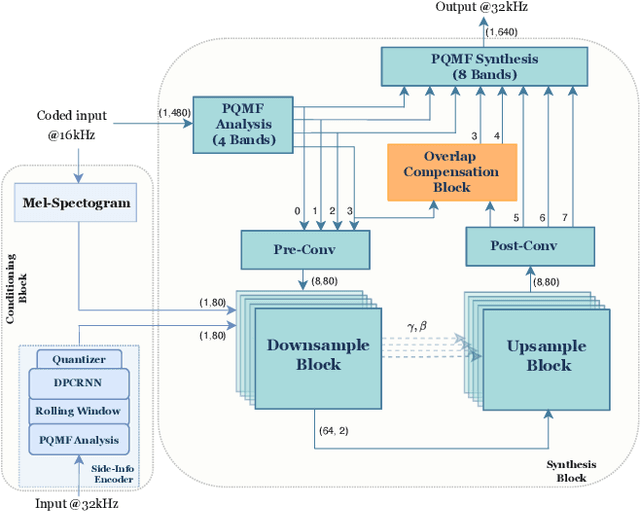
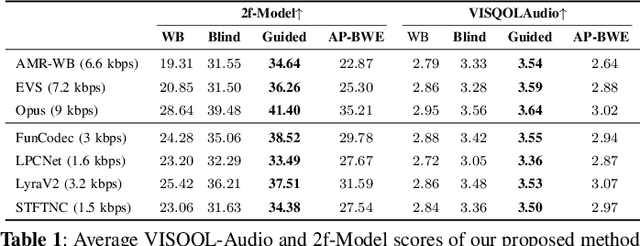
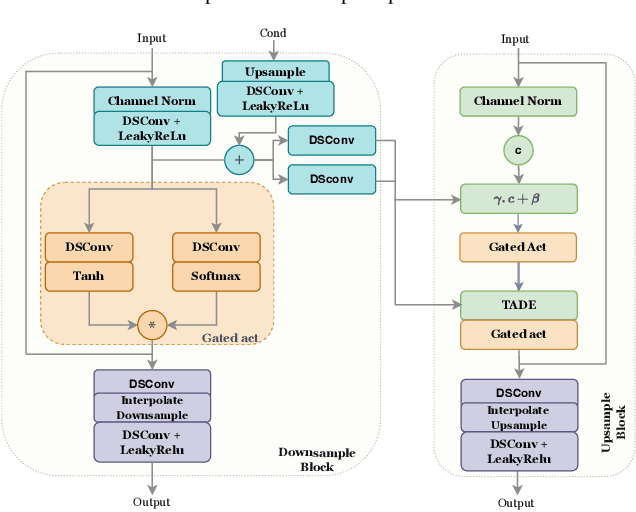

Abstract:In practical application of speech codecs, a multitude of factors such as the quality of the radio connection, limiting hardware or required user experience necessitate trade-offs between achievable perceptual quality, engendered bitrate and computational complexity. Most conventional and neural speech codecs operate on wideband (WB) speech signals to achieve this compromise. To further enhance the perceptual quality of coded speech, bandwidth extension (BWE) of the transmitted speech is an attractive and popular technique in conventional speech coding. In contrast, neural speech codecs are typically trained end-to-end to a specific set of requirements and are often not easily adaptable. In particular, they are typically trained to operate at a single fixed sampling rate. With the Universal Bandwidth Extension Generative Adversarial Network (UBGAN), we propose a modular and lightweight GAN-based solution that increases the operational flexibility of a wide range of conventional and neural codecs. Our model operates in the subband domain and extends the bandwidth of WB signals from 8 kHz to 16 kHz, resulting in super-wideband (SWB) signals. We further introduce two variants, guided-UBGAN and blind-UBGAN, where the guided version transmits quantized learned representation as a side information at a very low bitrate additional to the bitrate of the codec, while blind-BWE operates without such side-information. Our subjective assessments demonstrate the advantage of UBGAN applied to WB codecs and highlight the generalization capacity of our proposed method across multiple codecs and bitrates.
On the Design of Diffusion-based Neural Speech Codecs
Apr 11, 2025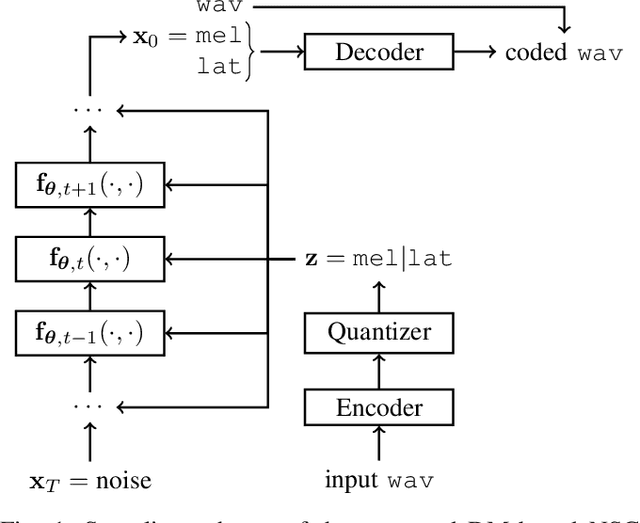
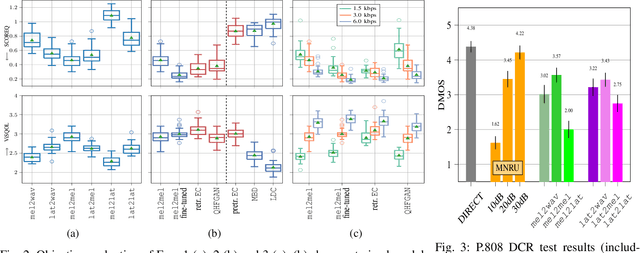
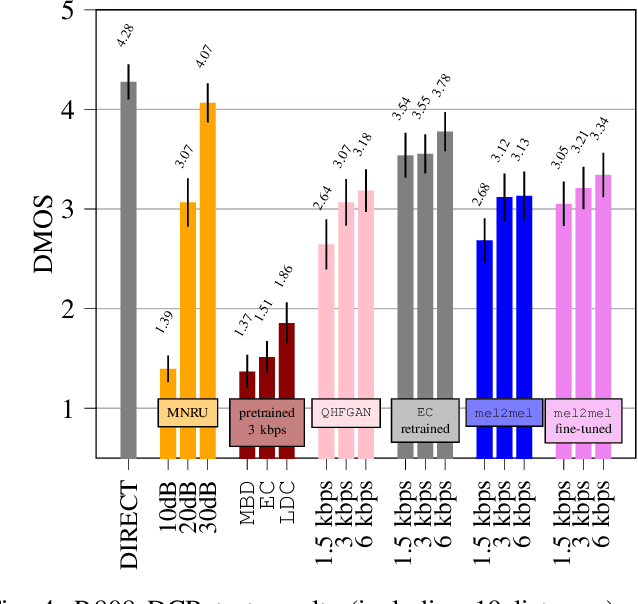

Abstract:Recently, neural speech codecs (NSCs) trained as generative models have shown superior performance compared to conventional codecs at low bitrates. Although most state-of-the-art NSCs are trained as Generative Adversarial Networks (GANs), Diffusion Models (DMs), a recent class of generative models, represent a promising alternative due to their superior performance in image generation relative to GANs. Consequently, DMs have been successfully applied for audio and speech coding among various other audio generation applications. However, the design of diffusion-based NSCs has not yet been explored in a systematic way. We address this by providing a comprehensive analysis of diffusion-based NSCs divided into three contributions. First, we propose a categorization based on the conditioning and output domains of the DM. This simple conceptual framework allows us to define a design space for diffusion-based NSCs and to assign a category to existing approaches in the literature. Second, we systematically investigate unexplored designs by creating and evaluating new diffusion-based NSCs within the conceptual framework. Finally, we compare the proposed models to existing GAN and DM baselines through objective metrics and subjective listening tests.
GAN-Based Speech Enhancement for Low SNR Using Latent Feature Conditioning
Oct 17, 2024



Abstract:Enhancing speech quality under adverse SNR conditions remains a significant challenge for discriminative deep neural network (DNN)-based approaches. In this work, we propose DisCoGAN, which is a time-frequency-domain generative adversarial network (GAN) conditioned by the latent features of a discriminative model pre-trained for speech enhancement in low SNR scenarios. Our proposed method achieves superior performance compared to state-of-the-arts discriminative methods and also surpasses end-to-end (E2E) trained GAN models. We also investigate the impact of various configurations for conditioning the proposed GAN model with the discriminative model and assess their influence on enhancing speech quality
Comparative Analysis Of Discriminative Deep Learning-Based Noise Reduction Methods In Low SNR Scenarios
Aug 26, 2024



Abstract:In this study, we conduct a comparative analysis of deep learning-based noise reduction methods in low signal-to-noise ratio (SNR) scenarios. Our investigation primarily focuses on five key aspects: The impact of training data, the influence of various loss functions, the effectiveness of direct and indirect speech estimation techniques, the efficacy of masking, mapping, and deep filtering methodologies, and the exploration of different model capacities on noise reduction performance and speech quality. Through comprehensive experimentation, we provide insights into the strengths, weaknesses, and applicability of these methods in low SNR environments. The findings derived from our analysis are intended to assist both researchers and practitioners in selecting better techniques tailored to their specific applications within the domain of low SNR noise reduction.
Blind Acoustic Parameter Estimation Through Task-Agnostic Embeddings Using Latent Approximations
Jul 29, 2024Abstract:We present a method for blind acoustic parameter estimation from single-channel reverberant speech. The method is structured into three stages. In the first stage, a variational auto-encoder is trained to extract latent representations of acoustic impulse responses represented as mel-spectrograms. In the second stage, a separate speech encoder is trained to estimate low-dimensional representations from short segments of reverberant speech. Finally, the pre-trained speech encoder is combined with a small regression model and evaluated on two parameter regression tasks. Experimentally, the proposed method is shown to outperform a fully end-to-end trained baseline model.
On Improving Error Resilience of Neural End-to-End Speech Coders
Jun 13, 2024Abstract:Error resilient tools like Packet Loss Concealment (PLC) and Forward Error Correction (FEC) are essential to maintain a reliable speech communication for applications like Voice over Internet Protocol (VoIP), where packets are frequently delayed and lost. In recent times, end-to-end neural speech codecs have seen a significant rise, due to their ability to transmit speech signal at low bitrates but few considerations were made about their error resilience in a real system. Recently introduced Neural End-to-End Speech Codec (NESC) can reproduce high quality natural speech at low bitrates. We extend its robustness to packet losses by adding a low complexity network to predict the codebook indices in latent space. Furthermore, we propose a method to add an in-band FEC at an additional bitrate of 0.8 kbps. Both subjective and objective assessment indicate the effectiveness of proposed methods, and demonstrate that coupling PLC and FEC provide significant robustness against packet losses.
Simple and Efficient Quantization Techniques for Neural Speech Coding
May 14, 2024Abstract:Neural audio coding has emerged as a vivid research direction by promising good audio quality at very low bitrates unachievable by classical coding techniques. Here, end-to-end trainable autoencoder-like models represent the state of the art, where a discrete representation in the bottleneck of the autoencoder has to be learned that allows for efficient transmission of the input audio signal. This discrete representation is typically generated by applying a quantizer to the output of the neural encoder. In almost all state-of-the-art neural audio coding approaches, this quantizer is realized as a Vector Quantizer (VQ) and a lot of effort has been spent to alleviate drawbacks of this quantization technique when used together with a neural audio coder. In this paper, we propose simple alternatives to VQ, which are based on projected Scalar Quantization (SQ). These quantization techniques do not need any additional losses, scheduling parameters or codebook storage thereby simplifying the training of neural audio codecs. Furthermore, we propose a new causal network architecture for neural speech coding that shows good performance at very low computational complexity.
End-To-End Deep Learning-based Adaptation Control for Linear Acoustic Echo Cancellation
Jun 04, 2023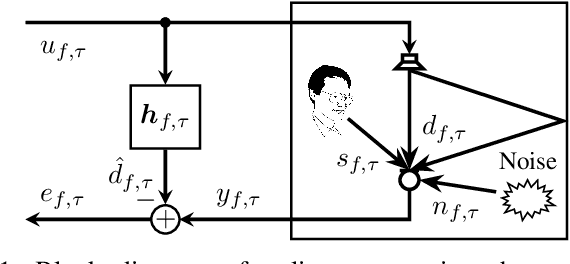
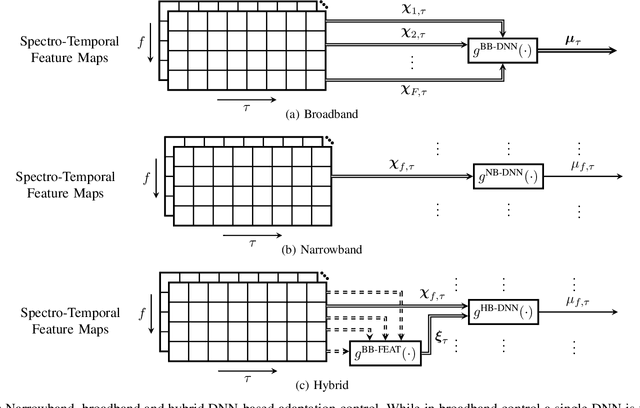

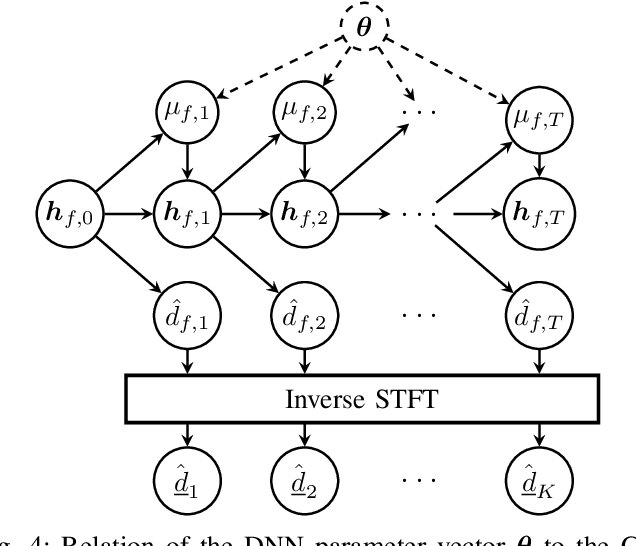
Abstract:The attenuation of acoustic loudspeaker echoes remains to be one of the open challenges to achieve pleasant full-duplex hands free speech communication. In many modern signal enhancement interfaces, this problem is addressed by a linear acoustic echo canceler which subtracts a loudspeaker echo estimate from the recorded microphone signal. To obtain precise echo estimates, the parameters of the echo canceler, i.e., the filter coefficients, need to be estimated quickly and precisely from the observed loudspeaker and microphone signals. For this a sophisticated adaptation control is required to deal with high-power double-talk and rapidly track time-varying acoustic environments which are often faced with portable devices. In this paper, we address this problem by end-to-end deep learning. In particular, we suggest to infer the step-size for a least mean squares frequency-domain adaptive filter update by a Deep Neural Network (DNN). Two different step-size inference approaches are investigated. On the one hand broadband approaches, which use a single DNN to jointly infer step-sizes for all frequency bands, and on the other hand narrowband methods, which exploit individual DNNs per frequency band. The discussion of benefits and disadvantages of both approaches leads to a novel hybrid approach which shows improved echo cancellation while requiring only small DNN architectures. Furthermore, we investigate the effect of different loss functions, signal feature vectors, and DNN output layer architectures on the echo cancellation performance from which we obtain valuable insights into the general design and functionality of DNN-based adaptation control algorithms.
 Add to Chrome
Add to Chrome Add to Firefox
Add to Firefox Add to Edge
Add to Edge